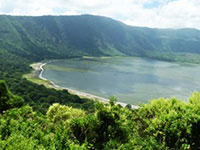The drive from Lake Manyara is 80 km (50 miles) and takes approximately 1 hour. From Tarangire, it is a 180 km (110 miles) road trip and takes approximately 2 and half hours. From Arusha it takes approximately 4 hours (190 Kms) You can also fly from Arusha or Kilimanjaro Airport to Lake Manyara and then it is 80 km (50 miles) to The Ngorongoro Crater
The Ngorongoro Conservation area is a UNESCO World Heritage Site and International Biosphere Reserve which covers almost 8,300 km². When visiting you will indulge your senses in incredible natural landscapes, thrilling archaeological sites, and the people of the area, not to mention the phenomenal wildlife it has to offer. The area has volcanoes, forests and grasslands and is also home to the Maasai tribe.
The crater is a stupendous natural wonder of the world and sits right in the middle of the Ngorongoro Conservation Area. The bottom of the crater is renowned for incredible opportunities to see game, you could view some extremely rare animals (e.g. black rhino) as well as many different herds of animals.
Originally, The Ngorongoro Crater was volcanic and was formed approximately 20 million years ago as part of the Rift Valley. The rim of the crater is high, standing at 2220 m (1.4 miles) so take a jacket or sweater as it can get chilly! The steep walls at the side of the crater rise over 600 m from the floor and it is the most magical area in the conservation area guaranteed to enthral every person who visits.

The crater is home to 30,000 animals including “The Big Five”; buffalo, elephants, leopards, lions and rhino. As well as those animals, it is home to cheetah, hartebeest, hippos, hyenas, jackals, reedbuck, warthog, serval, waterbuck, wildebeest, zebra and hundreds of birds as well as thousands of insects.
Very close to the centre-point of The Ngorongoro Conservation Area are two smaller craters which are ideal for keen walkers and hiking safaris.

The Empakaai Crater is 6 km wide and its walls rise to almost 300 m. Half of the crater’s floor is a deep salt-water lake which is favoured by waterbuck and eland. Travelling down the lake, you will see buffalo, bushbuck, blue monkeys and rare birds including turacos and sunbirds. The base of the crater’s floor is the perfect viewing point of OldoinyoLengai, an active volcano. On a clear day, you can see the snowy peaks of Mount Kilimanjaro.

This is the second crater which has a shallow base covered in grass. Here you should be able to see some of the Maasai tribe with their livestock as well as wild buffalos, reedbuck and eland. Crossing the crater is The Munge River which leads into a mesmerising waterfall which falls hundreds of metres.

It was on this site in 1959 when Dr Louis Leakey and his wife Mary discovered the remains of the first fossilised Proconsul skull (an extinct ape) believed to be one of the man’s ancestors.
A safari around the Northern Tanzania Circuit follows a popular safari route.
Optional Activities in Northern Tanzania.